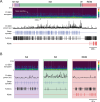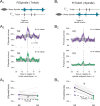This is a preprint.
Twitches during N2 and N3 are coupled with sleep spindles but not delta oscillations in 6-month-old infants
- PMID: 40777480
- PMCID: PMC12330768
- DOI: 10.1101/2025.07.23.666445
Twitches during N2 and N3 are coupled with sleep spindles but not delta oscillations in 6-month-old infants
Abstract
Twitches are discrete movements that characterize REM sleep. However, recent work showed that twitches also occur during NREM sleep in human infants beginning around 3 months of age, a time when sleep spindles and the cortical delta rhythm are also emerging. Further, NREM twitches co-occur with sleep spindles, suggesting a unique functional role. Given that NREM sleep is composed of distinct substages, we investigated whether twitching and twitch-spindle coupling are differentially expressed during N2 and N3 sleep. In 6-month-old human infants (n=21; 7 females), we recorded EEG, respiration, and video during daytime sleep. We found that the high intensity of twitching during N2 resembled REM more than N3. In contrast, sleep spindles exhibited similar temporal characteristics during N2 and N3. Also, despite differences in the intensity of twitching during N2 and N3, significant twitch-spindle coupling occurred in both stages. Finally, twitch rate was inversely related to delta power across NREM periods. These findings suggest that although twitching occurs during REM, N2, and N3 sleep at this age, its expression is compatible with some sleep components (e.g., rapid eye movements, sleep spindles) but not others (e.g., cortical delta), highlighting the continuing need to better understand the dynamic organization of sleep and its individual components in early development.
Keywords: delta oscillations; development; infancy; myoclonic twitches; sensorimotor system; sleep spindles.
Figures






Similar articles
-
Prescription of Controlled Substances: Benefits and Risks.2025 Jul 6. In: StatPearls [Internet]. Treasure Island (FL): StatPearls Publishing; 2025 Jan–. 2025 Jul 6. In: StatPearls [Internet]. Treasure Island (FL): StatPearls Publishing; 2025 Jan–. PMID: 30726003 Free Books & Documents.
-
Vagal heart rate variability during rapid eye movement sleep reduces negative memory bias.Front Behav Neurosci. 2025 Feb 24;19:1513655. doi: 10.3389/fnbeh.2025.1513655. eCollection 2025. Front Behav Neurosci. 2025. PMID: 40066370 Free PMC article.
-
Widespread decoupling of spindles and slow waves in temporal lobe epilepsy.Epilepsia. 2025 Jul;66(7):2421-2432. doi: 10.1111/epi.18359. Epub 2025 Mar 14. Epilepsia. 2025. PMID: 40085127 Free PMC article.
-
The Black Book of Psychotropic Dosing and Monitoring.Psychopharmacol Bull. 2024 Jul 8;54(3):8-59. Psychopharmacol Bull. 2024. PMID: 38993656 Free PMC article. Review.
-
Effects of opioid, hypnotic and sedating medications on sleep-disordered breathing in adults with obstructive sleep apnoea.Cochrane Database Syst Rev. 2015 Jul 14;(7):CD011090. doi: 10.1002/14651858.CD011090.pub2. Cochrane Database Syst Rev. 2015. PMID: 26171909
References
Publication types
Grants and funding
LinkOut - more resources
Full Text Sources
